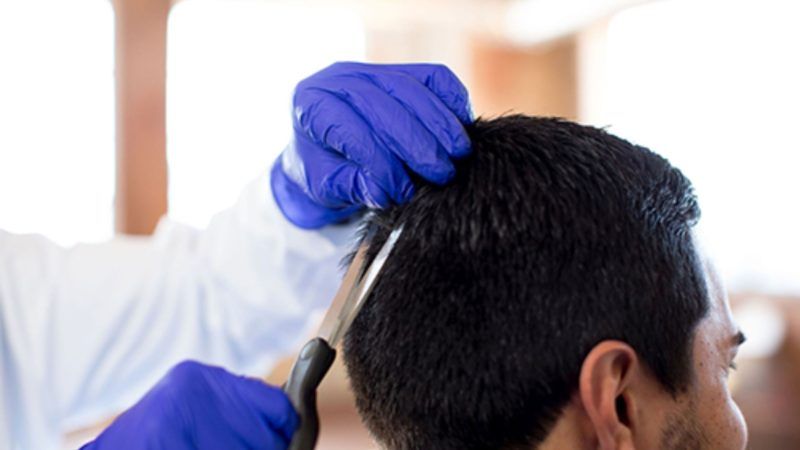Federal Proposal Would Expand Hair Testing of Job Applicants and Employees To Make Sure They Are Obeying Drug Prohibition
The method, which can detect drug metabolites for up to a year, does not measure impairment or recent use.

A rule recently proposed by the Substance Abuse and Mental Health Services Administration (SAMHSA) revives the previously rejected idea of using hair tests in drug screening of federal employees and workers in federally regulated industries. The proposed rule, which was published last week, says "hair testing potentially offers several benefits when compared to urine," including "a longer window of drug detection."
If the aim of these tests is to identify workers whose job performance is affected by psychoactive substances, that "benefit" is actually a disadvantage. Metabolites do not show up in hair until after a drug's effects have worn off and typically can be detected for up to three months. Depending on hair length and growth rate, the detection window can be as long as a year. In other words, hair testing does not detect impairment or even recent use. There is a similar problem with urine testing, but the detection period for urinalysis is much shorter—a few days after a single dose of marijuana, for example, or as long as a month for regular cannabis consumers.
Another widely recognized problem with hair tests is that their results are affected by hair color. SAMSHA acknowledges "scientific evidence that melanin pigments may influence the amount of drug incorporated into hair." In one study cited by SAMSHA, for example, "codeine concentrations in black hair were seven-fold higher than those in brown hair and 14-15-fold higher than those in blond hair." As the agency notes, such findings "have raised concerns that selective drug binding with the wide variation of color pigments distributed amongst the population may introduce bias in drug test results."
The implication is that people with darker hair—blacks and Hispanics, for example—are more likely to lose their jobs or have their applications rejected as a result of a positive hair test. "It is mind-boggling that the federal government is revisiting this half-baked proposal now," says Paul Armentano, deputy director of the National Organization for the Reform of Marijuana Laws (NORML). "Given the heightened awareness surrounding the need for social and racial equity, the idea of proposing a testing procedure that will inherently deny more people of color opportunities than it would others who have engaged in exactly the same activities is beyond tone deaf and counterproductive."
SAMSHA's proposal, which would allow the use of hair samples in pre-employment screening and random testing by federal agencies, is also likely to be adopted by the Nuclear Regulatory Commission and the Department of Transportation, which regulates industries such as trucking and railroads. SAMSHA projects that the rule would lead to 275,000 hair tests by federal agencies each year, plus 15,000 tests in the nuclear industry and 1.5 million in the transportation sector.
Based on the relevant case law, SAMHSA notes, "an employment action taken on the basis of a positive hair test alone, without other corroborating evidence, may be vulnerable to legal challenge." The rule therefore would require a confirmatory urine or saliva test.
SAMSHA says "this two-test approach is intended to protect federal workers from issues that have been identified as limitations of hair testing, and related legal deficiencies." But it suggests that a second test might not be required for marijuana metabolites: "The Department is specifically requesting comments, including support from the recent scientific literature, on whether hair tests that are positive for the marijuana analyte, delta-9-tetrahydrocannabinol-9-carboxylic acid (THCA), should be excluded from the requirement to test an alternate authorized specimen."
Pre-employment and random hair analysis is likely to identify many cannabis consumers and other drug users whose choice of recreational intoxicants when they are not at work is irrelevant to their job performance. On the face of it, firing or refusing to hire those people makes as much sense as rejecting or dismissing people based on a positive hair test for alcohol.
Despite the weak empirical basis for workplace drug testing, employers who demand urine from job applicants traditionally have argued that they are trying to filter out the sort of people who disobey the drug laws, which they view as a marker of antisocial and irresponsible tendencies. Given the ongoing collapse of marijuana prohibition, that argument is becoming increasingly tenuous as applied to cannabis consumers, the group most commonly identified by drug testing.
Employers who use pre-employment urinalysis also maintain that it identifies applicants who are either too dependent or too stupid and reckless to stop smoking pot in time to pass a test they know they will have to take. But that argument is hard to take seriously if employers use a test that can detect drug metabolites for up to a year.
Marijuana Moment notes that SAMSHA wrote its proposal without consulting the federal Drug Testing Advisory Board. "These proposed guidelines were developed without the expertise needed to ensure that they are scientifically accurate and defensible," board member Michael Schaffer, a toxicologist who works for the hair testing company Psychemedics, told Freight News. But Schaffer's main objection is that SAMSHA's guidelines are too restrictive. "I fear that these proposed guidelines are going to unnecessarily restrict the use of hair drug testing, an incredibly effective tool at detecting drug use, for reasons which have no scientific basis," he said.
NORML's perspective, as you might expect, is rather different. "Hair follicle testing is well established to possesses limited probative value, which is why it has never gained a particularly strong foothold in the general workplace," it says. "Federal authorities have also rejected the inclusion of hair follicle testing in the federal workplace drug testing guidelines on multiple occasions dating back decades." Given the manifest weaknesses in the case for hair testing, it is best viewed as yet another way of enforcing drug prohibition and punishing people who defy it.



Show Comments (82)